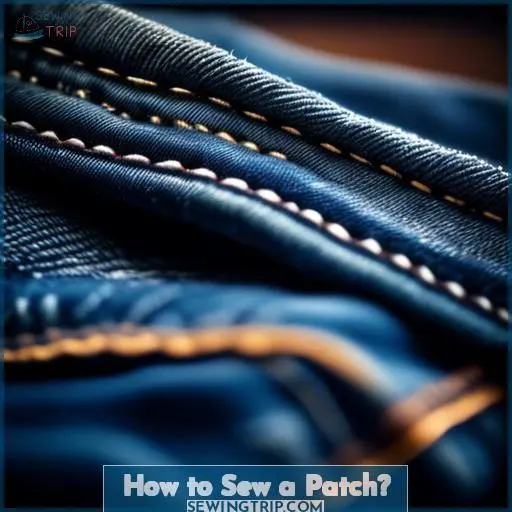This site is supported by our readers. We may earn a commission, at no cost to you, if you purchase through links.

To sew a tear in jeans by hand, you’ll need sharp scissors, a tapestry needle with a large eye and blunt tip, heavy-duty synthetic thread, spare fabric matching the denim color and texture, and denim thread. Start by trimming the frayed edges. Thread the needle and tie a knot. Sew stitches around the hole, tuck the thread inside the jeans, and tie off the thread.
For a patch, cut patch material to size, apply fabric glue to the edges, place the patch under the hole, and sew around the edges. Remember to use a thread that matches the denim color and sew 5 inches away from the hole edge.
Use the zigzag setting on a sewing machine, but be careful not to sew across pins.
Table Of Contents
Key Takeaways
- Use a needle with a sharp tip and a large eye, such as a tapestry needle, for hand sewing jeans.
- Trim frayed edges and apply fabric glue to the patch edges before sewing.
- Sew stitches around the hole, tucking the thread inside the jeans and tying off the thread.
- For a patch, cut patch material to size, apply fabric glue to the edges, place the patch under the hole, and sew around the edges.
How to Sew a Tear in Jeans by Hand?
To sew a tear in jeans by hand, follow these steps:
- Cut off the frayed edges around the tear with scissors.
- Turn your jeans outside in so your repair will be less visible.
- Sew the tear shut by hand using a thread that closely matches the color of the seams of your jeans.
- Remove any excess material or thread, and give your jeans a once over with an iron to smooth out any creases.
For larger tears or holes, you can also use fabric mending tape, darning with a sewing machine, or apply iron-on patches.
What Tools and Materials Do I Need?
To sew a tear in jeans by hand, you’ll need a few basic tools and materials. These include scissors, a needle, and heavy duty thread that matches the color of your jeans. You may also want to use a piece of spare fabric that closely matches the color and texture of your denim to patch over the torn area. Additionally, you can use denim thread, available at most fabric stores, to make an invisible repair.
Blanket stitching around the edges of the patch can prevent further fraying and add strength to the final seam.
Scissors
When you need to sew a small hole in your jeans, you’ll want to have the right tools at your disposal. Scissors are an indispensable part of your sewing kit, and selecting the right pair can have a significant impact on the success of your project. Here are some guidelines for choosing the best scissors for your denim repair:
- Needle size: Look for scissors with a sharp, pointed tip that can easily penetrate denim fabric. A larger needle size will provide greater control and accuracy when sewing around the hole.
- Thread weight: Consider the thickness of the thread you’ll be using. Heavier thread may require more robust scissors to cut through it effectively.
- Stitch length: If you’re using a sewing machine, choose scissors with a long blade that can easily reach the stitching area. For hand sewing, a shorter blade may be more comfortable and easy to handle.
- Hand sewing vs. machine sewing: Depending on your preference and the size of the hole, you may opt to use hand sewing or machine sewing techniques. Hand sewing scissors should be smaller and more precise, while machine sewing scissors may have a longer blade for easier access to the sewing area.
- Blade type: Straight blades are suitable for cutting through denim, while wavy or serrated blades may be better for cutting through heavier fabrics.
Remember to choose scissors that are comfortable to hold and use, as they’ll be an essential part of your sewing process. Try out different pairs to find the one that feels most natural in your hand.
Needle
To sew a tear in jeans by hand, you’ll need a needle. Choose a needle with a large eye to accommodate thicker threads. For denim, use a tapestry needle, which has a large eye and a blunt tip. The needle’s thickness should match the thread you’re using.
For stitch patterns, consider using a running stitch, backstitch, or blanket stitch. Hand sewing techniques can include whipstitch, backstitch, or cross-stitch. Repair tools like thimbles can help protect your fingers.
Embroidery needles are thinner and can be used for embroidery or sashiko stitching. Darning needles are also useful for darning stitches.
Heavy Duty Thread
To mend a tear in your jeans, you’ll need a heavy-duty thread that can withstand the stress and tension of the denim fabric. Choose a thread that’s strong and durable, preferably made of synthetic materials like polyester or nylon. These threads are engineered to withstand high stress and tension, making them ideal for sewing thick materials like denim, canvas, and leather.
When selecting a thread, consider the weight and finish. A thicker thread will provide better stitch formation and can be used for bold topstitching, cording, and stitching buttonholes. For invisible repairs, opt for a clear monofilament nylon thread that’s high-strength and low-stretch.
Remember to choose a needle size that matches the thread you’re using. Heavier jeans threads work best with larger needle sizes, while finer threads require smaller needles. When sewing with polyester thread, use needle sizes from 70/10 to 110/18. For nylon thread, choose sizes from 46/45 to 277/270.
To make sure a strong and durable repair, use a sewing machine needle that’s designed for the type of thread you’re using. For example, use a denim sewing machine needle for sewing denim. Always check the thread tension on a scrap of old denim before starting your repair to avoid skipped stitches.
How to Sew a Small Hole?
You’ve got a small tear in your jeans, and it’s time to fix it up with some simple hand sewing. Grab your scissors, needle, and heavy-duty thread, and let’s stitch that hole closed to make your denim look good as new.
Trim Frayed Edges
Before you begin sewing, it’s essential to prepare the hole by trimming the frayed edges. This step guarantees that the patch will adhere adequately and the repair will be sturdy. Use scissors to remove any loose threads or fabric around the hole. For small holes, you can also consider using a rotary cutter or an X-Acto knife for accuracy.
Thread Needle and Tie Knot
To sew a small hole in your jeans, you’ll need a few tools and materials. Start by gathering a size 16 jeans needle, a Jean-a-ma-jig (a trademarked name for a tool that helps you sew over thick seams), and a sharp pair of scissors. For the thread, choose a type that matches the color of your denim. You can use a denim thread for a close match, or opt for a thread that’s slightly lighter than your jeans for a subtle repair.
Once you have your materials, follow these steps:
- Trim the frayed edges of the hole to prevent further damage.
- Thread a needle with your chosen thread color and tie a knot at the end.
- Sew stitches around the hole, making sure to keep the needle at a consistent distance from the hole’s edge.
- Tuck the thread inside the jeans to hide it from the outside.
- Tie off the thread inside the jeans, making sure the knot is secure.
Remember to be careful not to sew across any pins you may have used to hold the patch in place. Additionally, use a zigzag setting on your sewing machine for added strength and durability.
Sew Stitches Around Hole
To sew a small hole in your jeans, you’ll need to follow these steps:
- Trim the frayed edges of the hole with sharp scissors, ensuring a clean edge for easy repair.
- Thread a needle with a sharp point and tie a knot at the end.
- Sew stitches around the hole, keeping a consistent distance of about 0.5 inches away from the edge.
- Tuck the thread inside the jeans as you sew to avoid visible stitches on the outside.
- Tie off the thread inside the jeans once you’ve sewn all the way around the hole.
Remember to use a thread that closely matches the color of your denim for a discreet repair. Consider using sashiko thread, embroidery floss, button thread, or standard sewing machine thread for a close match. If you’re using a sewing machine, use a zigzag setting for added strength and to prevent the denim from catching on the needle. Be careful not to sew across pins while sewing.
Tuck Thread Inside Jeans
To safeguard your concealed repairs from detection, conceal the thread within the fabric of your jeans. This measure is of paramount importance for preserving the structural integrity of your denim and deterring frayed edges.
Invariably employ a needle gauge that aligns with the thread size and stitch length to achieve the best possible outcome.
For a more in-depth guide on mending a minor perforation, refer to our thorough article on restoring torn jeans.
Tie Off Thread Inside Jeans
To fasten the thread inside your jeans, first verify you have a needle with a sharp point and knot durability. Select a thread color that closely resembles the denim color for a subtle repair.
The thread thickness and stitch length will depend on the weight of your jeans and the desired strength of the repair. For a small hole, use a simple straight stitch length of 3.5.
Be aware of the tension on your sewing machine and adjust as needed to prevent catching the wrong part of your jeans with the needle.
How to Sew a Patch?
To sew a patch, start by cutting the patch material to size. Apply fabric glue to the edges of the patch to make sure it stays in place. Next, place the patch under the hole and sew around its edges using a needle and heavy duty thread. Remember to use a thread that matches the denim color and sew about 0.5 inches away from the hole edge. Finally, tie off the thread inside the jeans to keep the patch in place.
Cut Patch Material to Size
After trimming those frayed edges, it’s time to cut your patch material to size. Here’s how to make sure your patch isn’t just a fix, but a statement:
- Patch Size: Measure twice, cut once. Your patch should generously cover the hole, plus some.
- Patch Shape: Go beyond squares. Why not a star or heart for a bit of flair?
- Patch Color: Match for stealth or contrast for boldness. Remember, it’s your denim’s second chance to shine!
Apply Fabric Glue to Edges of Patch
To create a secure hold for your patch, apply fabric glue to the edges before sewing. This will guarantee the patch stays in place and provides an invisible repair. Choose a fabric glue that matches the denim color for a seamless blend.
Place Patch Under Hole
To place a patch under a hole in your jeans, follow these steps:
- Choose the right patch material: Select a patch that’s sturdy and contrasts or matches the color of the jeans. You can use a denim patch or a softer fabric for a decorative patch.
- Cut the patch to size: Make sure the patch is at least 1 inch larger than the hole on all sides.
- Prepare the jeans: Spread the jeans smooth and flat, and pin the patch in place.
- Position the patch: Place the patch over the hole with the right side of the patch pressed to the wrong side of the jeans.
- Baste the patch: Pin the patch in place to prevent it from slipping, and then baste it with a few stitches to secure its position.
- Choose the right needle: Use a heavy-duty needle that can pierce both the denim and patch.
- Sew around the edges: Sew around the edges of the patch, making sure to stitch through the folded under hem if using an exterior fabric patch.
- Trim excess threads: After sewing, trim off excess threads and turn the jeans right side out.
Remember to use a thread that closely matches the color of the denim and choose a stitch length of 3.5 for a simple straight stitch.
Sew Around Edges of Patch
To sew a patch onto your jeans, follow these steps:
- Choose the right patch size: Cut your patch material to be slightly larger than the hole you’re repairing.
- Apply fabric glue: Apply fabric glue to the edges of your patch to help it adhere to the denim.
- Place the patch under the hole: Position the patch under the hole in your jeans, with the glued edges facing up.
- Sew around the patch: Use a heavy-duty needle and thread that matches the color of your jeans. Sew around the edges of the patch, starting and stopping about 0.5 inches away from the hole’s edge.
- Tie off the thread: Tie off the thread on the inside of the jeans to secure the patch in place.
Remember to use a zigzag stitch on your sewing machine for added strength and flexibility. And if you’re using a decorative patch, consider using a thread color that closely matches the denim for a more subtle repair.
What Should I Remember?
When repairing a tear in your jeans by hand, remember to use a thread that closely matches the color of your denim. Also, sew about 5 inches away from the hole’s edge using a zigzag stitch on your sewing machine. Be careful not to sew across any pins you may have used for guidance.
Use Thread That Matches Denim Color
When choosing your thread color, think of it as your denim’s undercover ally—it should blend in, not stand out. Pick a hue that’s a close kin to your jeans’ shade, ensuring your stitches are incognito.
Sew 0.5 Inches Away From Hole Edge
Regarding ripped jeans repairs, various techniques are available. A common approach is stitching, utilizing a sewing machine to patch jeans from the interior. Alternatively, hand stitching is an option for mending minor tears.
For a durable solution, fabric glue can be applied to secure an iron-on patch. For an artistic touch, embroidery or darning stitches can conceal holes. Ensure thread matches denim color and sew 0.5 inches from hole edges for optimal results.
Use Zigzag Setting on Sewing Machine
To use a zigzag setting on your sewing machine for repairing ripped jeans, follow these steps:
- Select the zigzag stitch on your sewing machine: Look for the zigzag stitch option on your machine’s stitch selector. This stitch will create a decorative pattern that can help prevent fraying and provide extra strength to the repair.
- Adjust the stitch length and width: Zigzag stitches can vary in length and width. The length refers to the distance between each zigzag point, while the width indicates the high peaks of the zigzag. Adjust these settings based on the fabric and the desired look of your repair.
- Test your stitch tension: Before sewing, it’s important to check the tension settings on your sewing machine and do a test on a scrap of old denim to find the best results for your material. This will help make sure that the stitches aren’t too tight or too loose, which could affect the overall strength and appearance of your repair.
- Use a denim needle and thread: For the best results, use a denim needle and thread that closely matches the color of your jeans. This will help the repair blend in more seamlessly with the rest of the fabric.
- Sew carefully: When sewing the zigzag stitch, be careful not to sew across pins or other sewing tools. This can damage your machine or cause the stitches to become uneven.
Be Careful Not to Sew Across Pins
When patching up those jeans, remember it’s safety first—keep an eye on needle placement to avoid sewing over pins. It’s like dodging potholes on a road trip; you want a smooth ride, not a flat tire. Carefully removing pins as you go prevents damage to both your jeans and sewing gear. So, steer clear of those metal speed bumps!
What Are Some Tips for Repairing Ripped Jeans?
To repair ripped jeans, consider using a denim patch on the inside of the jeans to cover the hole and strengthen the surrounding area. Here are some tips to help you with the process:
- Use bonding web to keep the patch in place: Apply a layer of bonding web between the patch and the jeans to make sure it’s held firmly.
- Choose denim thread for an invisible repair: Match the thread color to the denim for a seamless repair.
- Use blanket stitching to prevent further fraying: This stitching technique can help reinforce the repair and prevent the hole from getting bigger.
- Consider using a denim sewing machine needle: This type of needle is designed for denim fabric and will make the sewing process smoother.
- Use a simple straight stitch length of 3.5: This stitch length is suitable for denim repair and provides a good balance between strength and flexibility.
- Check your thread tension on a scrap of old denim: Adjust the tension to make sure the stitch length is consistent and to avoid puckering.
- Gather up the denim and avoid catching the wrong part of your jeans with the needle: This will help prevent damage to the jeans and make the repair process smoother.
Remember to use a thread that closely matches the color of the denim and sew 0.5 inches away from the hole edge to make sure the repair is strong and durable.
Use Bonding Web to Hold Patch in Place
When mending those cherished jeans, a bonding web is your secret ally. It’s akin to an unseen but vital roadie for a rockstar. Its formidable adhesive prowess guarantees the precise positioning of your patch, effortlessly harmonizing material compatibility. Simply apply heat to achieve an invisible restoration that will revitalize your denim’s pristine appearance.
Use Denim Thread for Invisible Repair
To achieve an invisible repair, use denim thread that closely matches the color of your jeans. This is a critical step for a discreet repair. When selecting a thread, consider using Jean Stitch thread for a close match to the denim color. Double sewing machine thread can provide extra strength. Choose a thread that blends seamlessly with the denim for a subtle repair.
Blanket Stitching Can Prevent Further Fraying
Blanket stitching is a game-changer for preventing further fraying on your ripped jeans. This nifty technique uses a needle and thread to create a decorative border that seals the edges. Plus, it’s a breeze to do! Just select the right needle, apply some fabric glue, and stitch around the patch in a color that matches your denim. Easy peasy!
How to Repair Ripped Jeans?
To repair ripped jeans by hand, you can use several methods. You can stitch the tear using a sewing machine from the inside, or hand stitch a clean rip. Alternatively, you can apply an iron-on patch or use hand embroidery to mend the holes. If the damage is extensive, you can also use darning stitches to reinforce the area.
Stitching
To repair ripped jeans using stitching, you can patch jeans from the inside. Start by selecting a patch material that closely matches the denim color. Use a needle and heavy duty thread to sew around the edges of the patch, ensuring a secure hold.
For a more durable repair, consider using a darning technique, which involves weaving the thread in and out of the fabric. Remember to choose a thread that matches the denim color and use a needle size appropriate for the fabric.
Use Sewing Machine to Patch Jeans From the Inside
To patch jeans from the inside using a sewing machine, follow these steps:
- Open the leg of the jeans so you can work flat on the knee area.
- Rip the seam that isn’t flat felled, down to near the hem, but not through it, so you can darn or patch on flat fabric.
- Choose a needle size suitable for denim, such as a size 14/90 or 16/100.
- Set the thread tension to an appropriate level, considering the fabric type and the weight of the thread.
- Use a stitch length of 3.5 for the patching process.
- Sew around the edges of the hole or patch, ensuring you don’t catch the wrong part of the jeans with the needle.
- Be careful not to sew across pins, as this can cause damage to the fabric or the machine.
Remember to use a denim sewing machine needle and choose a thread color that matches the denim for a discreet repair. You may also want to use a zigzag stitch setting on your sewing machine for added strength and durability.
Hand Stitch a Clean Rip
To hand stitch a clean rip in your jeans, you’ll need a needle, thread, and a small piece of fabric for reinforcement. Choose a needle with a large eye for ease of threading, and select a thread that matches the color of your jeans for a discreet repair.
Use a simple straight stitch length of 3.5 and tie a knot at the end of your thread. Insert the needle through the denim at the edge of the tear, then weave it in and out of the fabric, keeping your stitches close together for strength.
Once you’ve sewn a few inches, tie off the thread and trim the excess. For added reinforcement, you can also apply a bonding web to the back of the patch before sewing it in place.
Iron-on
To repair your ripped jeans using an iron-on patch, start by selecting the appropriate ironing temperature for the type of patch material you’re using. Bonding fabrics together is key to achieving a strong and durable repair.
Choose an invisible patch for a seamless look, or a decorative patch for a more noticeable fix. Remember to follow the manufacturer’s instructions for the best results.
Apply Iron-on Patch
Applying an iron-on patch is a quick and easy fix for ripped jeans. First, choose a patch with a size that covers the hole. Then, set the iron to the appropriate heat setting for the patch material. Carefully place the patch on the jeans, aligning it with the denim color. Press the iron over the patch to adhere it to the jeans.
Remember to avoid using the iron on the jeans directly to prevent damage.
Embroidery
To mend holes in your jeans using embroidery, follow these steps:
- Choose embroidery techniques such as satin stitch, split stitch, or backstitch.
- Opt for needle sizes that suit your comfort level and fabric thickness.
- Select thread colors that blend well with your denim or create a contrast for a unique look.
- Experiment with patch shapes like hearts, stars, or geometric designs to add character to your jeans.
- Find design inspiration from vintage clothing, art, or nature to create a personalized touch.
Mend Holes With Hand Embroidery
Hand embroidery is a creative and personal way to mend a rip in your jeans. To get started, you’ll need a few supplies: matching fabric scraps, embroidery needles, embroidery floss, a template, and a water-soluble pen. Here’s a step-by-step guide to mending your jeans using hand embroidery:
- Cut a scrap larger than your hole: Use pinking shears to create a decorative edge that will prevent fraying.
- Slip it inside the pant leg and baste it in place: This will help you position the patch correctly and keep it from shifting during the stitching process.
- Lay out your silhouette and trace: Choose a design that complements your jeans and the size of the hole.
- Stitch, stitch, stitch: Use a variety of stitches to create texture and visual interest. You can hide your starting and ending knots by going through the hole.
- Use water to get rid of the outline: Once you’re satisfied with your embroidery, use water to dissolve the water-soluble pen marks.
- Fill in more if desired: If you want to add more details or color, you can continue stitching.
- Trim the back: Use pinking shears to trim the back of the patch, if desired.
- Remove basting threads: Carefully cut and remove the basting threads that held the patch in place.
Darning
Darning is a darning technique that can be used to repair ripped jeans. Here’s how to do it:
- Prepare Your Tools: Gather a denim needle, heavy duty thread, and a scrap of old denim for testing thread tautness.
- Test Thread Tautness: Sew a few stitches on the scrap denim to ensure proper tautness.
- Sew the Rip: Using a simple straight stitch and a denim needle, sew along the rip, keeping the needle in the same hole as much as possible.
- Check Your Work: Once finished, check your repair for any loose threads or gaps.
Use Darning Stitches
To repair a hole in your jeans using darning stitches, follow these steps:
- Prepare the hole: Trim the frayed edges of the hole to create a clean edge for sewing.
- Choose the right thread: Select a thread that closely matches the color of your jeans. You can use sashiko thread, embroidery floss, button thread, or standard sewing machine thread.
- Thread the needle: Use a darning needle, which has a larger eye and is easier to thread with thicker threads.
- Start stitching: Begin by making a series of straight stitches across the hole, working from one side to the other. Make sure to keep the stitches close together to reinforce the area.
- Finish the stitching: Once you’ve completed the straight stitches, you can either tie off the thread on the inside of the jeans or weave in the ends to create a more invisible repair.
Remember to be patient and take your time, as darning stitches can be time-consuming but effective in repairing torn jeans.
Frequently Asked Questions (FAQs)
What is the best needle size for hand sewing jeans?
To hand sew jeans, you should use a needle with a sharp tip and a large eye. A size 4 or 5 hand sewing needle would be suitable for this task, as it’s strong enough to pierce through the denim fabric and has a large enough eye to accommodate the thread.
Can I use a sewing machine to repair a small hole in jeans?
Yes, you can use a sewing machine to repair a small hole in jeans. Using a sewing machine for this task can be more efficient and produce more durable stitches compared to hand sewing.
Keep in mind that using a sewing machine requires a needle appropriate for denim, such as a denim or jeans needle, which can be found in various sizes like #110/18 or #16/
Additionally, you should use a zigzag stitch setting on your sewing machine to make sure the thread doesn’t break while sewing through the thick denim fabric.
How do I prevent fraying when sewing a patch on jeans?
To prevent fraying when sewing a patch on jeans, follow these steps:
- Trim frayed edges: Carefully trim any frayed edges around the hole using sharp scissors. This creates a clean area to work with and helps prevent further unravelling.
- Apply fabric glue: Apply fabric glue to the edges of the patch to secure it in place.
- Place patch under hole: Place the patch under the hole and align it with the edges of the tear.
- Sew around edges: Sew around the edges of the patch, ensuring that the stitches are close to the edges of the hole for reinforcement.
- Tie off thread: Tie off the thread inside the jeans to secure the patch.
- Use zigzag setting: Use a zigzag stitch setting on your sewing machine to sew around the edges of the patch for added strength and durability.
- Be careful with pins: Avoid sewing across pins to prevent damage to your jeans.
- Use bonding web: If you’re hand sewing, use a bonding web to hold the patch in place.
- Match thread color: Use a thread color that closely matches the color of the denim to make sure a discreet repair.
What type of thread should I use for repairing a tear in jeans?
To sew a tear in jeans by hand, you should choose a thread that closely matches the color of the denim. This will help make the repair less noticeable when wearing the jeans. Sashiko thread, embroidery floss, button thread, or standard sewing machine thread can all be used for this purpose. Aim to use thread that matches the color of the denim for a discreet repair.
When repairing a tear in jeans by hand, it’s important to use a thread that closely matches the color of the denim. This will help make the repair less visible when you’re wearing the jeans. You can use a variety of thread types for this, including sashiko thread, embroidery floss, button thread, or standard sewing machine thread. The key is to choose a thread that closely matches the color of the denim so the repair blends in seamlessly.
Can I use a different color thread for a more visible repair on jeans?
Yes, you can use a different color thread for a more visible repair** on jeans. The thread color should match the denim color for a seamless repair, but if you want a more visible repair, you can choose a contrasting color. For example, using a variegated blue and red sashiko thread can create a unique and eye-catching repair.
Remember to use a thread that’s durable and comfortable, such as kogin thread, which is known for its durability and softness.
Conclusion
Let’s call it a new beginning for your beloved denim. With the right tools and a bit of patience, you’ve learned how to sew a tear in jeans by hand, transforming a mishap into a masterpiece.
You’re not just fixing jeans; you’re crafting a story with every stitch.












